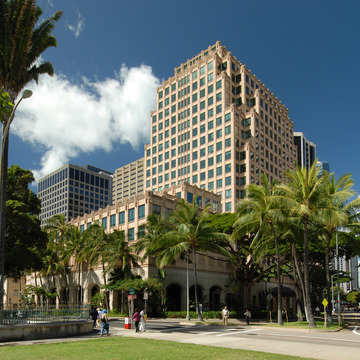Honolulu's finest example of Postmodern historicism, Alii Place harkens back to 1930s-era skyscraper designs. With its graduated setbacks, Art Deco–inspired corner capitals and parapets, and encircling arcade, reminiscent of the former Theo Davies Building (demolished) on Bishop Street, this twenty-three-story office building and its adjoining nine-story, one-thousand-car parking garage are compatible neighbors for the historic buildings of the Capitol Historic District.
Rising from a polished granite course, the cast-concrete, segmental-arched arcade emulates Kansas limestone. The arcade lucidly defines the base of the building from which the blush-toned, precast-concrete-panel-clad body ascends. The walls change colors with the mood of the sky and glisten in the sun thanks to the addition of feldspar in the concrete. The green window mullions pick up the pigment of the neighboring Iolani Palace (OA51) fence. The curve of the bus stop's domed roof on Hotel Street follows the line of the arcade's segmental arches. Further enlivening the Hotel Street frontage is the eight-pointed, star-shaped, granite-veneered fountain, which also ties into the building through its materials. The inset mauka entrance's 9 × 16–foot mosaic mural by Yvonne Cheng depicts Hawaiian aliʻi (members of the ruling class). Inside, the polished granite– and marble-clad lobby, with its variety of coved ceilings, follows the exterior's Art Deco details in its lighting and geometric accents.


